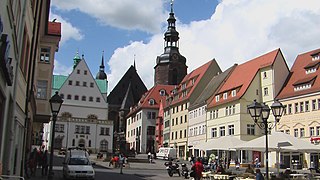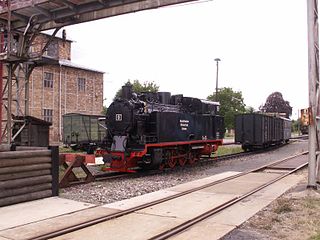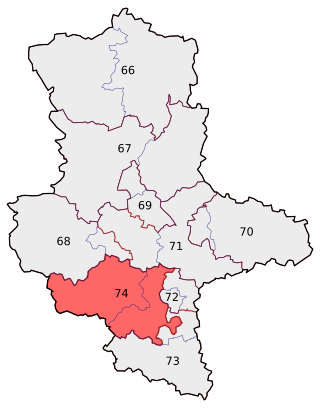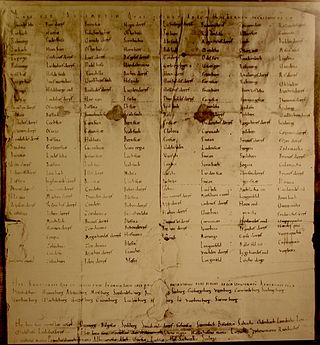Mansfeld Land (German : Mansfelder Land) is a region in the southwestern corner of the German state of Saxony-Anhalt. The region derives its name from the counts of Mansfeld, who ruled this region for about 1,000 years.
In the west and northwest, Mansfeld Land covered the eastern foothills of the Harz Mountains and is bounded in the east by the River Saale. To the north and south the territories of the two former county towns of Eisleben and Hettstedt form the boundary, whilst the territories of Sangerhausen and the town of Mansfeld form the border in the southwest to west.
Until the Second World War, Mansfeld Land was made up of the counties of Mansfelder Gebirgskreis (roughly northwest of a line from Annarode via Siersleben to Gerbstedt) and Mansfelder Seekreis (villages southeast of the line).
After the foundation of East Germany, these 2 counties were disbanded and transferred to the counties of Hettstedt and Eisleben, small areas of Mansfeld Land in the west went to Sangerhausen and in the south to Saalkreis and Querfurt.
Since the county reform of 2007, Mansfeld Land – after several years as the independent county of Mansfelder Land – has belonged to the county of Mansfeld-Südharz.
The extent of Mansfeld Land described above is roughly identical with the former County of Mansfeld.
Located not far from the Halle-Leipzig industrial region and the heavily industrial province of Halle, Mansfeld Land was one of the most important industrial conurbations in East Germany. Copper mining and the smelting of copper and its roughly 80 accessory metals played a major role. All copper mining, processing and manufacturing firms in the whole of East Germany were operated under the umbrella of the Mansfeld combine, Wilhelm Pieck, which also ran the Mansfeld Mining Railway. Prior to that it was the Mansfeld Company for Mining and Smelting (Mansfeld AG für Bergbau und Hüttenbetrieb).
The closure of mines and smelteries that had been working for almost eight hundred years resulted in an abrupt change to this monostructured economic area whose problems were exacerbated by the political changes of 1989/90. And newly created business parks and the remediation of contaminated sites did not bring the expected economic recovery.
The region has the right environment for recreational and cultural tourism around the lake of Süßer See south of Eisleben and in the Harz Foreland and the Luther memorial sites in the Lutheran towns of Eisleben and Mansfeld.
Since 1946 the town of Eisleben has had the official "nickname" of the Luther town (Lutherstadt). That takes into account the fact that Martin Luther was born here shortly before his parents moved the few kilometres to Mansfeld. Coincidentally, Luther died in his native town, where he was staying to mediate a dispute between the counts of Mansfeld (one branch of whom maintained a town castle in Eisleben).
Tourist attractions include the houses where the Reformer was born and died.
The town of Mansfeld was - as regards Luther - always rather overshadowed by the larger Eisleben; after the Wende Mansfeld was allowed to bear the official name: "Mansfeld-Lutherstadt".
Today, on the remaining stretch of railway line from Klostermansfeld to Hettstadt via Siersleben, trains of the old Mansfeld Mining Railway recall formerly busy operations on this narrow gauge industrial railway that linked all the shafts, numerous smelteries and other premises of the Mansfeld combine. In addition to its very wide-ranging goods traffic, the mining railway also ran passenger services - and primarily commuter services for the workers.

Saxony-Anhalt is a state of Germany, bordering the states of Brandenburg, Saxony, Thuringia and Lower Saxony. It covers an area of 20,451.7 square kilometres (7,896.4 sq mi) and has a population of 2.17 million inhabitants, making it the 8th-largest state in Germany by area and the 11th-largest by population. Its capital is Magdeburg and its largest city is Halle (Saale).

Mansfelder Land was a district (Kreis) in the middle of Saxony-Anhalt, Germany. Neighboring districts were Aschersleben-Staßfurt, Bernburg, Saalkreis, Merseburg-Querfurt, Sangerhausen and Quedlinburg. It was merged on July 1, 2007, with Sangerhausen into the new district Mansfeld-Südharz as part of a reform.

The Province of Saxony, also known as Prussian Saxony was a province of the Kingdom of Prussia and later the Free State of Prussia from 1816 until 1944. Its capital was Magdeburg.

Eisleben is a town in Saxony-Anhalt, Germany. It is famous as both the hometown of the influential theologian Martin Luther and the place where he died; hence, its official name is Lutherstadt Eisleben. First mentioned in the late 10th century, Eisleben is divided into old and new towns, the latter of which was created for Eisleben's miners in the 14th century. As of 2020, Eisleben had a population of 22,668. It lies on the Halle–Kassel railway.

Sangerhausen is a town in Saxony-Anhalt, central Germany, capital of the district of Mansfeld-Südharz. It is situated southeast of the Harz, approx. 35 kilometres east of Nordhausen, and 50 km (31 mi) west of Halle (Saale). About 26,000 people live in Sangerhausen (2020).

Mansfeld, sometimes also unofficially Mansfeld-Lutherstadt, is a town in the district of Mansfeld-Südharz, in Saxony-Anhalt, Germany.
Seegebiet Mansfelder Land was a Verwaltungsgemeinschaft in the Mansfeld-Südharz district, in Saxony-Anhalt, Germany. It was situated between Eisleben and Halle (Saale). The seat of the Verwaltungsgemeinschaft was in Röblingen am See. It was disbanded on 1 January 2010.
Röblingen am See is a village and a former municipality in the Mansfeld-Südharz district, Saxony-Anhalt, Germany. Since 1 January 2010, it is part of the municipality Seegebiet Mansfelder Land, of which it is the administrative centre.
Siersleben is a part of the town Gerbstedt and a village in the Mansfeld-Südharz district, Saxony-Anhalt, Germany. It is located 10 km north of the Lutherstadt Eisleben and 5 km south of Hettstedt and has a population of 1,472 people.

The Province of Halle-Merseburg was a province of the Free State of Prussia from 1944 to 1945. The provincial capital was the city Merseburg.

The Mansfelder Bergwerksbahn is an 11-kilometre (6.8 mi) long 750 mm gauge heritage railway in Saxony-Anhalt, Germany.

The Halle–Hann. Münden railway is a 218 km long main line operated by the Deutsche Bahn in Germany, which links Halle (Saale) in Saxony-Anhalt with Hann. Münden in the state of Lower Saxony. It is mainly used by regional and east-west goods trains. From 1990 to 1994 it was upgraded as part of a German Unification Transport Project.

The Helme is river in central Germany that is about 65 kilometres (40 mi) long and which forms a left-hand, western tributary of the Unstrut in the states of Thuringia and Saxony-Anhalt.

The Mitteldeutsche Zeitung is a regional daily newspaper for southern Saxony-Anhalt, Germany. Published in Halle with several local versions, the paper is owned by M. DuMont Schauberg, Cologne.

The Röhrigschacht is an old copper slate mine which is now a mining museum and show mine in the village of Wettelrode in the county of Mansfeld-Südharz in the German state of Saxony-Anhalt.

Mansfeld is an electoral constituency represented in the Bundestag. It elects one member via first-past-the-post voting. Under the current constituency numbering system, it is designated as constituency 74. It is located in southern Saxony-Anhalt, comprising the Mansfeld-Südharz district and most of the Saalekreis district.

Sangerhausen station is a station in the town of Sangerhausen in the district of Mansfeld-Südharz in the German state of Saxony-Anhalt. It was opened for passenger operations in 1866. It became a junction station in 1881 with the opening of the Sangerhausen–Erfurt railway. A new station building was built after the Second World War, which is now heritage-listed. In the past, it was served by long-distance traffic. Extensive modernisation of the platforms and buildings have taken place since 2014.

Sandersleben station is the station of Sandersleben in the German state of Saxony-Anhalt. It lies at the crossing of the Halle–Vienenburg and the Berlin–Blankenheim railway lines in the municipality of Arnstein and was used to connect between two different concentration camps facilitated by the Nazis.

The Hersfeld Tithe Register is a list of the places and castles in the Friesenfeld Gau (territory) and in Hassegau, from which Hersfeld Abbey received tithes. The original document dates from between 881 and 887 or between 896 and 899, but no longer exists. The list is found in a transcript from the 11th Century, which is now in the Hessischen Staatsarchiv Marburg.